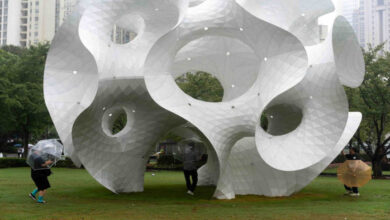Ancient ‘Dragon City’ on show in NYC | Partners | Belarus News | Belarusian news | Belarus today | news in Belarus | Minsk news | BELTA

BEIJING, 6 September (BelTA — China Daily) — Some 1,600 years ago, long
before modern globalization, a vibrant cultural melting pot existed in a
region of Northeast China known as «Dragon City» — present-day Chaoyang
in Liaoning province.
People from different corners of the Asian continent converged on the region from the years 337 to 436.
The
fascinating details are part of an exhibition at the China Institute
Gallery in New York City titled Gold from Dragon City: Masterpieces of
Three Yan from Liaoning, 337-436, which opened on Thursday.
The
story of the civilization established by the nomadic Murong Xianbei
people is being presented in the United States for the first time.
Among
the artifacts on display are glass cups, inkstones and tiger-shaped
vessels from Han Chinese culture. There are long swords used by the
Xianbei people.
Jointly organized by the China Institute Gallery
and the Liaoning Provincial Museum, the exhibition illustrates the
history of ethnic integration and cultural exchange along the Silk Road,
which transformed North China.
Gold from Dragon City, which will
run through Jan 5, 2025, also features treasures from nearly 70 years
of archaeological excavations in China, including sculptures, bronze
mirrors, imperial seals, equestrian objects, ceramics and jewelry, many
made of gold.
«Gold holds the greatest significance and value in
Chinese culture. Within the broader historical framework of diversity
and inclusiveness in Chinese culture, the Three Yan civilization is also
an important and valuable part,» Liu Ning, deputy director of Liaoning
Provincial Museum, told China Daily.
«This extraordinary
exhibition illustrates the remarkable achievements of the Three Yan
civilization, which is now no longer lost to history,» said Willow
Weilan Hai, director and chief curator of China Institute Gallery. «We
have gained a deeper understanding of how ethnic integration and the
cultural exchange of East and West inspired and enriched cultures along
the Silk Road.»
Upon entering the gallery, viewers will first see
two sculptures of the heads of men who are not Han Chinese, with high
nose bridges and deep-set eyes. Hai explained that the entrance
highlights the diversity of the society then in that region.
«To
understand the globalization that occurred in the ancient world, you see
that it’s not that different from what’s happening today. What’s
important is how understanding different people and their cultures —
where they came from — helps us communicate better,» Hai told China
Daily.
The highlight of the exhibition — a series of golden
headdress ornaments worn by the Murong Xianbei people — features
shimmering, swaying leaves, known as buyao, which literally means
«swaying with steps».
Described by Hai as «an Asian fashion of
the time», the metal leaf design came from Western Asia and was
introduced to North China through the Silk Road. Over time, the design
became a key feature of the Three Yan culture.
Revolutionary invention
Also featured are the earliest known stirrups in human history, a revolutionary invention that transformed cavalry and warfare.
With
the stirrups, early warriors were able to free both hands for combat.
Made from finely crafted mulberry wood and gilt bronze, the stirrups are
considered masterpieces of gilded craftsmanship of the Northern Yan
during the Sixteen Kingdoms period (304-439).
«It was the Chinese
invention of the stirrup that made Western medieval knights possible
and gave us the age of chivalry,» historian Robert Temple wrote in his
book The Genius of China: 3,000 Years of Science, Discovery, and
Invention.
On Oct 19, an international symposium, «Along the
Steppe-Silk Road: Studies on Mysterious Nomad Murong Xianbei», will be
held at the China Institute Gallery.






